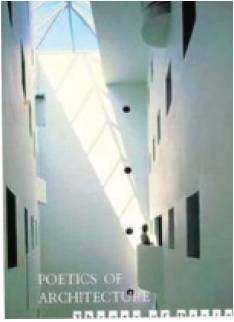In a book presenting a theory of design, it must address the aspects of imagination and creativity as well as the right way through which one can achieve a truly significant architectural design.
Poetics of Architecture represents the efforts of one teacher/architect for ‘peace’ and ‘evaluation’ for the benefit of architecture.
The whole premise of this book is that architectural thought, methods of design exploration, and ultimately architecture as built today are much richer than they were during the earlier part of the century, the period of the Modern movement. It explores the fundamental theories of Modern and Postmodern design and attempts to reconcile all that is worthwhile in these two movements into a new inclusivist attitude toward architecture. Anthony C Antoniades looks at the many intangible and tangible channels one can harness in creating architectural design. By opening architecture to the full range of creative influences, he tries to help readers produce designs that are richer on spatial, sensual, spiritual, and environmental levels.
Some of the intangible channels of creativity explored in the book include fantasy, metaphor, the paradoxical and metaphysical, the primordial and untouched, poetry and literature, and the exotic and multicultural. Among the tangible channels covered are history and the study of precedents, mimesis and literal interpretation, geometry, materials and the role of nature. The author presented a rich and imaginative discussions of these various channels, explaining which are were favored during the Modern and Postmodern movements and classifying his theoretical analysis through the use of many vivid examples, tables and illustrations. Included among the examples in the volume are many distinguished projects and theories by a wide range of noted architects such as Asplund, Aalto, Utzon, Pikionis, Barragin, Pietila, Predock, and Legarreta, who are latecomers to the attention of the media.
It summarizes the findings and transformation in biology and the theory of knowledge and suggests an architectural analogue. It concludes with a suggestion for a transformational attitude via the methodology of simultaneity. In this book poetry and literature are portrayed as two powerful vehicles to architectural design. According to the author a designer should have a “poetic palette” that includes local as well as universal ingredients. He has discussed about the cross-culture fertilization which leads to the birth of the exotica. He addressed both the “physical” and “metaphysical” nature of exotica. Also discussed about the multicultural nature of recent educational trends that have brought the element of the exotic into the design studio. The categories of exotic design exercises are presented, along with projects from the author’s personal experience.
Author says that Architectural history is the qualitative differential that distinguishes architects among themselves. He discussed the differences between history and historicism, and presented arguments for the right use of both. He defined the “inclusivist” appreciation of history as opposed to the “partiality” of historicism, addressed the concept of the correct use of history, and made suggestions for selecting the right kind of precedents. He concluded that to improve upon the style, the architects need to raise their “historical sense”.
The book covers the origin, definitions, and opposing attitudes of scholars and aesthetes on mimesis, literal interpretation, and their associated concepts (immitation, derivation). One should be cautious when creating through this channel, and adopt the attitude of “implementability” as a way to safeguard against the dangers of misuse while achieving useful ends from both mimesis and literality.
It addresses the supermacy of geometric over analytical depiction, and the reasons for the appeal of geometry over the years. The early emphasis of aesthetes on geometry was partial, with a focus on elevations, proportional systems, and the concept of “symphonic composition”. It also discusses about the relationship of the various building types and their corresponding fit with geometry and the concept of “geometric fields” is viewed through both historical examples and contemporary complex building types. The caution he gave is that geometry can be misused when the emphasis is on form as opposed to the inclusivist concerns.
Author gave special attention to the construction materials, selection and their proper use. According to him materials are the flesh, bones, and skin of architecture. The Modern and Postmodern movements differ with regard to the criteron of materials as “day” and “night”, the Postmodern being total failure in this regard. Discussion focuses on the use of materials by successful architects such as H.H.Richardson, Frank Lloyed Wright, Louis I.Kahn, and Alvar Aalto. Author suggested for the enrichment of design education by extra emphasis on materials through their incoporation into design studio work.
Antoniades also provided fascinating material on the study of architectural biographies as a means of achieving an all-inclusive creativity in architectural design. Highly original yet based on solid principles, POETICS OF ARCHITECTURE will help architects, designers and students increase their versatility and creativity in the studio. It will also deepen their understanding and appreciation of the creative process and its many influences.
This book review was written by: Asim Bikash Mandal


Leave a Reply
You must be logged in to post a comment.